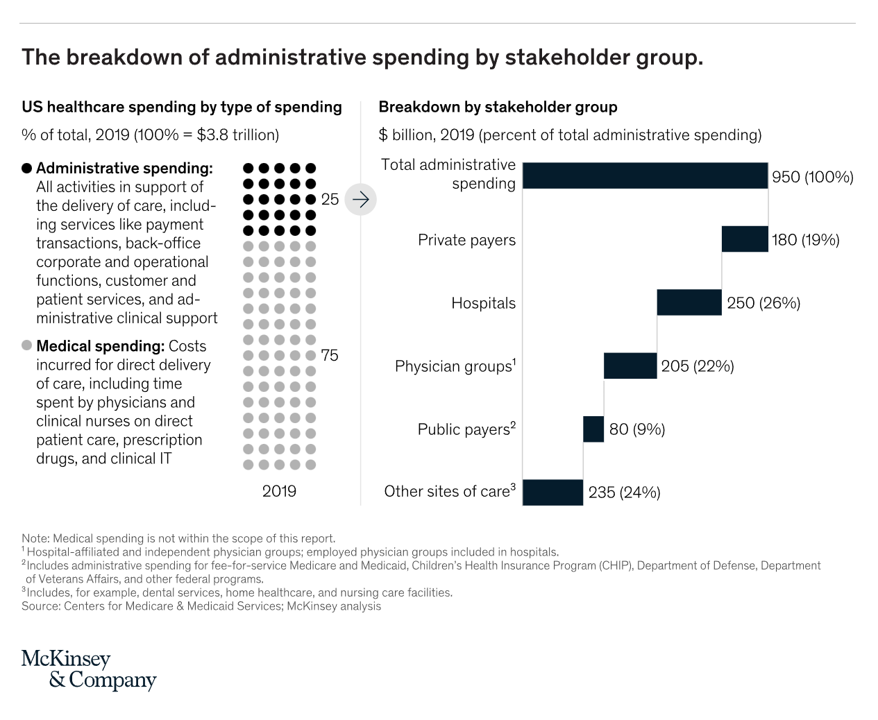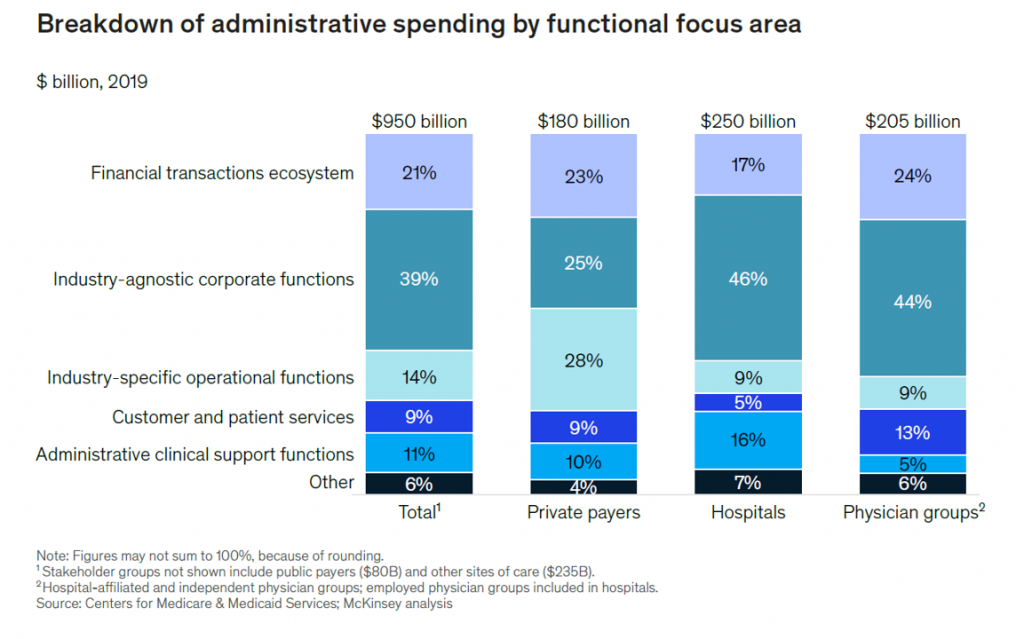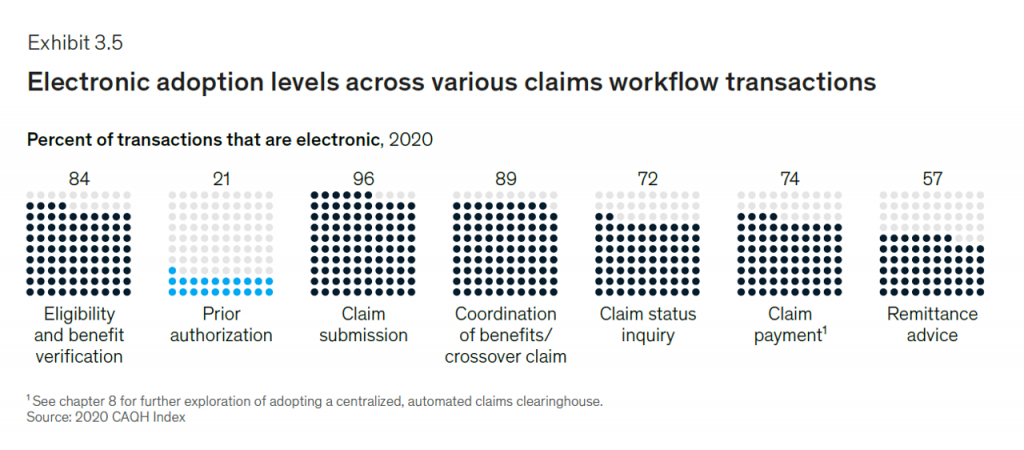In the U.S., “Health care is complicated because complexity is profitable.”
So explain Bob Kocher, MD, and Anuraag Chigurupati, in a viewpoint on Economic Incentives for Administrative Simplification, published this week in JAMA.
Dr. Kocher, a physician who is a venture capitalist, and Chigurupati, head of member experience at Devoted Health, explain the misaligned incentives that impede progress in reducing administrative spending.
 This essay joins two others in the October 20, 2021 issue of JAMA which highlight administrative spending in American health care:
This essay joins two others in the October 20, 2021 issue of JAMA which highlight administrative spending in American health care:
- Administrative Simplification and the Potential for Saving a Quarter-Trillion Dollars in Health Care by Nikhil Sahni, Brandon Carrus, and David Cutler (from Harvard and McKinsey); and,
- Administrative Expenses in the US Health Care System – Why So High? asked and answered by Michael Chernew and Harrison Mintz, both of Harvard Medical School.
Sahni and colleagues published the data-details in an article published by McKinsey & Company, the top-line of which appears in the first graphic from the publication.
Administrative spending comprise 25% of the $3.8 trillion of health care spending in 2019; medical spending received 75% of the U.S. health care dollar.
 What’s included in that admin spend includes:
What’s included in that admin spend includes:
- “Industry-agnostic” corporate functions such as general administration, human resources, nonclinical IT, sales and marketing and finance;
- Financial transactions, such as claims processing, revenue cycle management, and prior authorization (about $200 bn annually); and,
- Customer and patient services (such as call centers, all together worth about $80 bn/year).
The team noted in their JAMA viewpoint that over 1 million administrative employees were added to U.S. health care employment since 2001, today accounting for twice as many staff as physicians and nurses.
Addressing administrative flows both inside and outside health care organizations can save money; take the lack of interoperability between claims systems between payers and hospitals and other aspects of lack of standardization and fragmented data systems. This represents a $210 billion savings opportunity, shown in the McKinsey model.
At the industry level, Sahni’s team calculated a potential $105 bn of savings each year by streamlining the financial transactions ecosystem and operational functions like clinical credentialing.
Taken in aggregate, the administrative cost conserving potential is over one-quarter of a trillion (with a “T”) dollars each year — equal to about $1300 per U.S. adult.
 Health Populi’s Hot Points: Consider just the line item of “customer and patient services,” and one of all of our least-favorite patient experiences: the dreaded call center.
Health Populi’s Hot Points: Consider just the line item of “customer and patient services,” and one of all of our least-favorite patient experiences: the dreaded call center.
This last graphic from the McKinsey report illustrates the pain points for patients engaging with payers’ call centers. There’s lot of friction and unpleasantness in this experience.
At the same time, patients-as-consumers are clamoring for delightful digital journeys on par with their best retail experiences, from health care and every touchpoint they encounter.
Sadly, the latest ACSI Index gauging customers’ satisfaction with health plans and hospitals found these experience to be on par with the US Postal Service, gas stations, and other less-than-stellar experience performers with the Net Promoter Scores to prove it.
As it turns out, the health plans that served up the best digital experiences via well designed apps and websites garnered higher experience scores.
Holding health care back is the lack of digitization in general, and then the under-investment in user-centered design to engage and then retain patients beyond an initial download or visit to a patient portal.
 This diagram from the McKinsey study organizes data from a project with which I’d been long affiliated, the CAQH Index of electronic adoption of claims transactions. We’re talking claims here — not an app to manage a complex condition like diabetes or even a medication adherence tool.
This diagram from the McKinsey study organizes data from a project with which I’d been long affiliated, the CAQH Index of electronic adoption of claims transactions. We’re talking claims here — not an app to manage a complex condition like diabetes or even a medication adherence tool.
Claims — that’s the paper-based workflow that eats up some of the $billion U.S. health care administrative spend that could be freed up to, for example, cover more peoples’ health insurance or extend food benefits to bolster nutrition security and prevent physical wasting during cancer treatment for a person enrolled in Medicaid.
Paper Kills, as Newt Gingrich asserted in 2005 talking about the importance of electronic medical records about the time we started the CAQH Index project. It still does.




 I am so grateful to Tom Lawry for asking me to pen the foreword for his book, Health Care Nation,
I am so grateful to Tom Lawry for asking me to pen the foreword for his book, Health Care Nation,  I love sharing perspectives on what's shaping the future of health care, and appreciate the opportunity to be collaborating once again with Duke Corporate Education and a global client on 6th May. We'll be addressing some key pillars to consider in scenario planning such as growing consumerism in health care, technology (from AI to telehealth), climate change, and trust -- the key enabler for health engagement or dis-engagement and mis-information. I'm grateful to be affiliated with the corporate education provider
I love sharing perspectives on what's shaping the future of health care, and appreciate the opportunity to be collaborating once again with Duke Corporate Education and a global client on 6th May. We'll be addressing some key pillars to consider in scenario planning such as growing consumerism in health care, technology (from AI to telehealth), climate change, and trust -- the key enabler for health engagement or dis-engagement and mis-information. I'm grateful to be affiliated with the corporate education provider  Thank you FeedSpot for
Thank you FeedSpot for